Korean-Inspired English Words
Anytime a language comes in contact with another language, the two languages borrow from each other. Each will take new terms and phrases from the other language. If a language has not been exposed to something (like technology or food item), it will often base its new word on the foreign language. Sometimes phrases are borrowed that better explain the world or offer some insight into a culture. Today we will examine “9” Korean loanwords that have made their way into English dictionaries.
The goal of a dictionary is to describe the words that a language uses. A dictionary is a reporter. It is not the dictionary’s job to make new words or to decide the correct way of using a word. The dictionary only reports how those words are being used. At the end of this article, you will see a spreadsheet representing the data I collected from twelve dictionaries. I will also give a short explanation about why I chose certain dictionaries.
There are only five Korean-inspired words that were universally included. They are kimchi, taekwondo, Moonie, chaebol, and Korean. I am using the term Korean-inspired as some of these words are not found in the Korean language and thus can not be considered a loan word. However, they exist because of Korea and tell us a little about the country.
Finally, in this article I will be adding information behind the words I searched. I will write a word like kimchi (12/12) to show that it appears in 12 out of 12 dictionaries I used in my research. I feel that this will be a faster way to give you that information as this is going to be a long article. Even though there are nine words in the list, they are used to explain a little about Korea. There are for more words explained in this article.

Hanguk
The most surprising word that is missing from Google Dictionary is Korea (10/12). All of the other online dictionaries included it. The name, Korea, comes from a mispronunciation of Goyeo, a former dynasty on the Korean peninsula. The Korean word for Korea is Hanguk (한국) and it is included in five of the dictionaries. I was not expecting that, but I was pleasantly surprised by its inclusion.
It seems that some dictionaries do not include the names of places. I would imagine that there are so many cities, regions, counties, and areas in the world that adding English spellings of these places would make the dictionary extremely large. That being said, some Korean cities are mentioned.
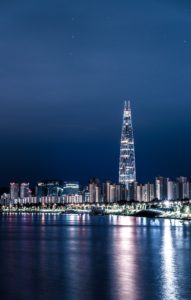 Seoul
Seoul
The largest city, and the political capital of Korea, is Seoul (9/12). Approximately 10 million people live in Seoul, which is about one fifth of Korea’s population. Seoul is cultural, financial, entertainment, and political center of the country. Seoul has pretty much anything you want to do. There are cultural landmarks, theater, k-pop, art exhibits, parks, mountains, shopping and really anything you want. It is no wonder it is the top tourist destination.
Busan
The second largest city by population is Busan (8/12). It is also the second most visited city by tourists. Busan is a port city on the South-Eastern corner of the peninsula. The port allowed the city to connect to the rest of the world and grow. There are many beaches, coastlines, and mountains that make it a beautiful area. It has the feeling of a bustling city with a lot of nightlife and culture.
Incheon

Incheon (8/12) is most famous for its airport, Incheon International Airport. It is the point of entry for most visitors. In 2019, Incheon International Airport was the 14th busiest airport in the number of passengers according to the Port Authority of New York. Also, according to Airports Council International, it was also the 5th busiest airport for cargo. Skytrax also rated it as the 4th best airport in 2021 despite the pandemic. It has taken home the award twice before. Incheon is also a large city of three million people.
Jeju
Jeju (7/12) is a vacation destination. While it is an attraction for foreigners, Koreans also love having this southern island to travel to. During the Covid-19 travel restrictions, many Koreans chose to travel to Jeju instead of heading overseas. It is also a great destination for honeymoons. Jeju has its own distinct history and feels different from the rest of Korea. Like Hawaii for America, Jeju is a vacation destination for South Korea.
Gangnam Style
I also included Gangnam (4*/12) in my research due to the success of Gangnam Style, a song by the pop singer, Psy. The song made Gangnam, a district of Seoul, a household name in English-speaking countries. However, its popularity did not translate into recognition by most dictionaries. Only three of the dictionaries (The Free Dictionary, Wiktionary, and Urban Dictionary) included entries about the location. MacMillan Dictionary included Gangnam Style as an entry, as did Urban Dictionary. There was only one entry for Gangnam in Urban Dictionary but eight entries for Gangnam Style.
One thing that I should note about place names is that there does not seem to be consistency between dictionaries about spelling. Some dictionaries use the old romanization while others use the newer romanization. So, when looking for Jeju, you may need to search for Cheju instead. I hope that the dictionaries using the old romanization will update their entries or add another entry that links to their current entry.
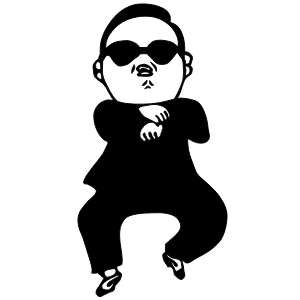
References
https://www.collinsdictionary.com/dictionary/english/korea
https://www.dictionary.com/e/korea/
https://worldpopulationreview.com/countries/cities/south-korea
https://en.wikipedia.org/wiki/Tourism_in_South_Korea
http://english.seoul.go.kr/
https://www.busan.go.kr/eng/index
https://www.urbandictionary.com/define.php?term=Gangnam%20style
2019 Annual Airport Traffic Report (PDF). United States: Port Authority of New York and New Jersey. 2020.
https://web.archive.org/web/20200525083649/https://aci.aero/news/2020/05/19/aci-reveals-top-20-airports-for-passenger-traffic-cargo-and-aircraft-movements/
https://www.worldairportawards.com/the-worlds-top-10-airports-of-2021/
https://en.yna.co.kr/view/AEN20210729004400315

Hangeul
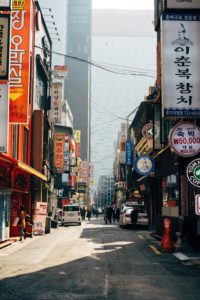
The national language of Korea is Korean (12/12). That is unsurprising. Korean can refer to the language of Korea or the people who inhabit it. However, Koreans do not call their language Korean, they call it Hangeul (2/12). Spelling 한글 in English relies on how it was romanized. In the year 2000, The South Korean Ministry of Culture revised the official romanization of Korean. They set out a correct way to spell Korean words in English. So, the correct way to spell is 한글 is Hangeul. However, more dictionaries use an older romanization of 한글 and spell it Hangul (8*/12). Even though there seems to be some confusion about this, I am still impressed that so many dictionaries included the romanization of the Korean spelling of Korean.
The New Romanization
The shift in romanization was a reflection of the times. The old way of romanizing was not good for the computer age. The accented characters were harder to type and find on a computer. The old characters were also not friendly towards foreigners and did not reflect the Korean language well. Some sounds in Korean are difficult to express with a Roman alphabet.
The decision to change how things are romanized also came at a great financial cost as many street signs and city names had to be changed. It is estimated that it cost the Korean government between $500-600 million USD to make the change. There still are some signs around Korea that were never replaced. They are not common but are a cute reminder of days gone by.
Proper names established before the new romanization were not required to change their spelling. It is why companies like Samsung (3/12) and Hyundai (3/12) use an older Romanization. Family names are also tricky in Korea. For the same reason as the company names, established family names can be written using older rules. There is no firm rule for spelling a family name in Korea. DC CopyPro took a deep dive into Korean names in his blogpost. If you want to learn more, I suggest reading his article.
Inventing an Alphabet
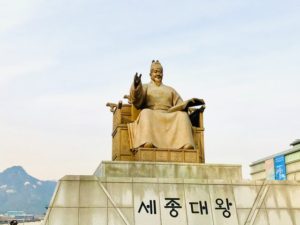
I didn’t even touch on the history of Hangeul in this section yet and I feel bad about it. Hangeul was invented by King Sejong the Great in 1443 during the Joseon (2/12) Dynasty. At that time, hanja (2*/12) was used. Hanja is based on Chinese characters and was difficult to understand. The common people could not write hanja. King Sejong was a man of the people and wanted a writing system that would connect all of Korea, no matter what social class you were a part of. This, of course, was against the wishes of the social elite.
The phonetic system he came up with was ingenious. Those circles and lines represent mouth and tongue shapes. The consonants and vowels can be combined into a symbol that represents a syllable. King Sejong went on to create a manual on how to use the new alphabet. It's amazing that Hangeul was not based on a previous alphabet or syllabary. Instead, it was created by taking a scientific approach to constructing an alphabet. King Sejong is considered one of (if not THE) greatest Korean who ever lived.
References
https://www.merriam-webster.com/dictionary/Korean
https://web.archive.org/web/20070916025652/http://www.korea.net/korea/kor_loca.asp?code=A020303
https://en.wikipedia.org/wiki/Romanization_of_Korean
https://dccopypro.com/2021/08/01/the-best-way-to-write-korean-names-in-english/
https://blogs.ubc.ca/etec540sept13/2013/10/27/hangeul-and-literacy-in-korea/
https://www.koreatimes.co.kr/www/art/2018/08/688_143968.html

Kimchi
One of the most representative symbols of Korea is kimchi (12/12). Kimchi is usually spicy, fermented cabbage but there are many different varieties with different ingredients. There are around 200 types of kimchi in Korea. You will receive it with almost all meals. Koreans consume about 57 pounds of it per capita each year. It is one of the healthiest foods in the world.
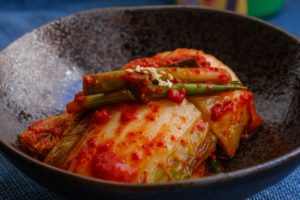
Kimchi has been around for about 1,500 years. And while its popularity seems to be declining, the reverence that this food gets is mind-boggling. There are kimchi fridges, kimchi festivals, and there is even a World Institute of Kimchi! The significance of kimchi can not be overstated. So, it is no wonder that it appears in all the dictionaries I looked at.
The names of foods are not easily translated into another language. Can you imagine calling kimchi, fermented vegetables garnished in spicy sauces and other vegetables? It just wouldn’t make sense. That is why it is common to find food names from other languages making their way into English.
Food is a big part of Korean culture but Kimchi is not the only representative food of Korea. I decided to look at some other popular dishes to see if they have made their way into English dictionaries.
Bibimbap
Bibimbap (10/12) is a dish of rice mixed with meat and/or vegetables. It is usually topped with some gochujang (7/12). Gochujang is a spicy paste mixed into a lot of Korean food. Speaking of mixed, bibimbap is served with rice at the bottom with the meat and vegetables on top. Everything is sorted and looks great. If it doesn’t come with gochujang, you can add it. A lot of bibimbap, especially Jeonju bibimbap, comes with a fried egg on top. It is almost a shame to mix all of it together before consuming it.
Bulgogi
Bulgogi (6/12) is thinly-sliced marinated beef. It is usually served over rice or wrapped in lettuce. Bulgogi literally translates to “fire meat.” Bulgogi is a favorite here in Korea. Taste Atlas ranks it second only to kimchi in popularity. There is also a belief amongst Koreans that foreigners really like bulgogi. It’s not my favorite Korean food, but it is quite delicious.
Galbi
Galbi (4/12) is another famed beef dish. Galbi is rib meat but it is different from what we think of ribs in North America. In Korea, ribs are thinly sliced strips of beef. Alternatively, pork ribs can be used as well. Galbi can be served with or without marinate and is usually cooked at a Korean barbeque. If you haven’t been to a Korean barbeque, it is a communal experience. You are given meat that you cook by yourself at the table. There is a heat source in the center of the table (grill, charcoal). With a lot of Korean barbeque dishes, you will receive lettuce and gochujang. You can wrap your meat in lettuce with some gochujang and garlic.
Other Korean Food
There are also a number of Korean foods that didn’t make it in the mainstream dictionaries yet that I would like to highlight. Sampgyeopsal (2/12) is another Korean barbeque favorite. It is a dish of pork bellies that you can cook like galbi. Kimbap (3*/12) is a seaweed roll similar to sushi rolls, but usually made without fresh seafood. Tteok (3*/12) is a Korean rice cake. It is made by beating cooked rice with a stick until it becomes glutinous. It is not that light crispy snack I grew up knowing as rice cake. Tteokbokki (3/12) is a snack food made from tteok. This Korean street food is cooked in a spicy sauce and also includes other vegetables like spring onions and my favorite, cabbage. Side dishes, banchan (3/12), are also very popular in Korea. And if you want to relax after a long day at work, try chimaek. Chimaek (0/12) is a portmanteau of fried chicken and maekju (beer). Fried chicken is actually quite popular. There twice as many fried chicken restaurants in Korea than McDonalds in the world.
Alcohol
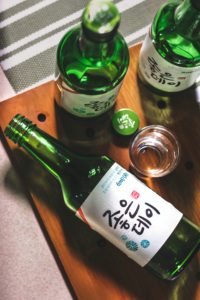
If you don’t like beer, maybe you would like to try another one of Korea’s alcohols. Soju (8/12) has been called, “Korean Vodka.” It is a clear, colorless, distilled alcohol usually made from rice or other grains. The drink is usually between 20 and 24 percent alcohol and is very cheap. It is no wonder that it is the second most popular drink in Korea (after beer). However, I prefer makgeolli (3/12). It is a milky-white, sparkling rice wine that is often served in a metallic bowl. The first time I was given it, I thought it was some weird soup or cereal. It is Korea’s oldest alcoholic beverage. It has a sweet and tangy taste. Also, it is a communal drink. It is often shared with friends.
Mukbang
Food is big part of Korean culture. Most Korean food is meant to be shared. When you order food at a restaurant, it is expected to be shared with everyone. The idea of ordering a plate of food for yourself is uncommon. Korean food culture has also produced a trend that has spread worldwide. Mukbang (6/12) is an online eating show. It grew in popularity through the early 2010s in Korea and the rise of YouTube. Now mukbang can be viewed in live streams and the audience can interact with the content creator. Would you like to be paid to eat? The word, mukbang, was on the short list for the Word of the Year in Collins dictionary.
Mukbang can be a profitable business. As far as I can tell, the largest Youtubers are Zach Choi with 12.8 million subscribers, Tanboy Kun with 13.4 million subscribers, and Jane ASMR with 14.3 million subscribers. DONA’s video, “NIK-L-NIP Wax Bottle…” has over 1 billion views on YouTube. If you are interested in mukbang, maybe these influencers are a good place to start.
References
https://www.sciencedirect.com/science/article/pii/S2352618115000451
https://www.health.com/condition/digestive-health/worlds-healthiest-foods-kimchi-korea
https://en.blog.kkday.com/25957/asia-south-korea-these-facts-about-kimchi-will-blow-your-mind
https://www.wikim.re.kr/index.es?sid=a2
http://world.kbs.co.kr/service/news_view.htm?lang=e&Seq_Code=34862
https://english.visitkorea.or.kr/enu/FOD/FO_ENG_2_2.jsp
https://www.tasteatlas.com/most-popular-food-in-korea
http://www.koreaherald.com/view.php?ud=20151005001042
https://www.collinsdictionary.com/woty
https://www.insider.com/mukbang-video-the-extreme-eating-trend-making-youtube-rich-2020-2#which-mukbangers-should-you-follow-2
https://www.youtube.com/user/xxxibchoi/featured
https://youtu.be/Ka4pKOuE5C8
https://www.youtube.com/c/Janeasmrr
https://www.youtube.com/c/tanboykun
https://www.klook.com/en-AU/blog/best-korean-fried-chicken-seoul/
https://vinepair.com/articles/soju-koreas-national-drink/
https://www.statista.com/statistics/943735/south-korea-most-favored-types-of-alcohol/
https://en.wikipedia.org/wiki/Makgeolli

K-Pop
Mukbang is one way that people come into contact with Korean culture, another way is through Hallyu (2/12). Hallyu is directly translated as “Korean wave,” and describes the phenomenon of Korean culture being spread around the world. It includes things like k-pop, k-dramas, movies, as well as Korean fashion.
The economy of Hallyu has risen from 1.87 billion USD in 2004 to 12.3 billion USD in 2019, helping push Korea to the 12th largest economy by GDP. Korea might be the only country that has made an effort to promote its “soft power” through media. And, it has worked. Tourism demand has risen due to Hallyu. Hallyu has introduced Korean culture and language to the outside world, but only a few of the words that have caught on.
The most popular word (according to the dictionaries I tested) is k-pop (10/12). K-pop describes Korean style pop music, but there is so much more than that. There is a certain style that goes with k-pop. You can’t ignore the influence of k-pop. In my post about “Selling Like Hotcakes”, we learned that BTS has four of the top five fastest-selling albums of all time. The other top five album is by Seventeen, another k-pop band. BTS also had the top two best-selling albums in 2020.
The value of k-dramas (3/12) is also a positive one on the Korean economy. A study on Chinese citizens found that they are more likely to buy Korean products if they watch k-dramas. Interestingly, the survey found that k-dramas don’t have a direct positive effect on Korea’s national image.
There are also a number of words associated with the rise in hallyu consumers. However, they haven’t had the impact on English dictionaries that I would have expected. An oppa (3/12) is an older brother. This word is probably the only other word you remember from Gangnam Style besides the title. A chobo (2/12) is a newbie or a beginner. I see chobo unjeon (초보 운전 = new driver) stickers on cars a lot in Korea. Aegyo (2/12) is a little more difficult to explain. It is sort of like being ultra-cute, baby-talk, or a cute display of affection.
References
https://en.wikipedia.org/wiki/List_of_fastest-selling_products
https://martinroll.com/resources/articles/asia/korean-wave-hallyu-the-rise-of-koreas-cultural-economy-pop-culture/
https://www.imf.org/en/Publications/WEO/weo-database/2021/April/
https://www.billboard.com/articles/news/9538406/bts-top-ifpi-global-album-sales-chart-2020/
https://jopeninnovation.springeropen.com/articles/10.1186/s40852-017-0075-y
https://www.researchgate.net/publication/282210730_Influence_of_Korean_Drama_Viewing_on_Korean_National_Image_Mediated_by_Consumption_of_Korean_Products_in_China

Kisaeng
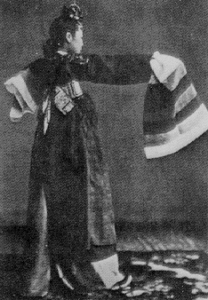 Hallyu is a more recent expression of Korean culture. It is very different from traditional Korean culture while still maintaining respect for the past. In this section, we will discuss some words related to Korean traditional culture that have made their way into English dictionaries.
Hallyu is a more recent expression of Korean culture. It is very different from traditional Korean culture while still maintaining respect for the past. In this section, we will discuss some words related to Korean traditional culture that have made their way into English dictionaries.
Kisaeng (4/12) were entertainers during the Goryeo and Joseon dynasties. They were usually very young and came from poor, outcast, or enslaved families. The lower class were called cheonmin (1/12). They provided entertainment to the aristocrats of the age, the yangban (3/12). One of the best outcomes was to become a concubine for a yangban. Kisaeng were skilled in conversation, music, fine art, and poetry. If you are interested in learning more about them, I will warn you that it is very difficult to read about how they (and other women) were treated during the Joseon Dynasty.
Traditional Korea
The kisaeng wore hanboks (5/12), traditional Korean clothing, when they did their performances. Performances might include the gayageum (2/12), a traditional Korean instrument. It is a type of zither that traditionally had 12 strings, but the are many variations. Remarkably, the gayageum musical tradition survived both Japanese and American occupation and still goes strong today. I highly recommend Luna Lee. She takes modern songs and plays them on the gayageum. It has a unique feel.
In other performances, the kisaeng might perform a (sijo 6*/12). Sijo is a loose form of poetry that is mostly improvisational. It was mostly written by kisaeng. Sijo poems are three lines long and were originally meant to be sung.
Some other Korean words related to traditional Korean culture include: pansori, hanji, and hanok. Pansori (2/12) is traditional throat singing in Korea. Hanji (3*/12) is a traditional paper made from mulberry trees. Finally, a hanok (3*/12) is a traditional Korean house. Korea has a long history, and I am glad some traditional words have made their way to English.
References
Lee, B. (1979). Evolution of the Role and Status of Korean Professional Female Entertainers (Kisaeng). The World of Music, 21(2), 75-84. Retrieved September 2, 2021, from http://www.jstor.org/stable/43560608
https://fluentkorean.com/gisaeng-the-flowers-of-joseon/
https://digitalworks.union.edu/cgi/viewcontent.cgi?article=1753&context=theses
https://www.masterclass.com/articles/how-to-write-sijo-poetry#how-to-write-sijo-stepbystep-guide
http://www.hanjinaty.com/p/what-is-hanji.html

Gook
The end of the kisaeng came with the Japanese invasion of 1910. The Japanese annexed Korea and forced out as much Korean culture as possible. Japan would occupy the Korean peninsula through both world wars. Japan was defeated in WW2 and Korea was divided between Russia (Soviet Union) and America. The Korean War (8/12) ended in a stalemate and separated the nation into North Korea and South Korea. Technically we are still at war. The Korean War is also known as the forgotten war in America because it occurred between the second world war and the Vietnam war. During these Asian wars, the word gook was created.
Gook (9/12) is a racist term for an Asian person. It mostly refers to Vietnamese, Philippine and Korean people as their countries were where America was fighting at the time. While the origin of the term is not clear, one theory is that it started in Korea. In Korea, migook saram (미국사람) means an American person. The soldiers stationed in Korea heard Koreans saying this and thought they were saying, “Me gook.” So, the Americans took this to mean Korean. Then, it was turned into a derogatory term and applied to other people, namely the Vietnamese people.
Haantan Virus
If the Korean war wasn’t bad enough, a new hantavirus (9/12) was spreading in the area around the Haantan River. It is a family of diseases that are transmitted by rats. Since it was discovered in the area around the Haantan River, it was given the name, Haantan Virus (3/12). During the Korean War, 3,000 cases were reported by UN troops. The cause was unknown until 1976 when Karl. M Johnson and Lee Ho Wang isolated the virus from the lungs of field mice.
Korean Martial Arts
In relation to war, I would also like to mention some traditional martial arts. The reason I want to shoehorn it in is because taekwondo (12/12) is one of the five words I found in all twelve dictionaries. It is culturally significant. There are many taekwondo academies in Korea and seeing kids in their gis walking around is not an uncommon sight. The sport has spread globally with eight million people in two hundred countries participating in the sport. Its popularity is why it is in the dictionary.
But, taekwondo is not the only Korean martial art. Hapkido (7/12) is similar to taekwondo but focuses more on throws, ground work and weapons. Ssireum (2*/12) is a traditional form of wrestling similar to sumo. Ssireum is much older than taekwondo or hapkido and might have been played during Korea’s tribal era. It is a popular sport to play during Chuseok (2*/12), Korea’s thanksgiving holiday (or mid-autumn festival).
(edit): A couple people have mentioned that the word gook likely comes from another source, and I agree. It is unlikely that this is the correct etymology, but I found it to be interesting a good opportunity to talk about another part of Korea's history, the war.
References
https://books.google.co.kr/books?id=xcf_4T-nPuoC&pg=PA118&redir_esc=y#v=onepage&q&f=false
https://www.kinu.or.kr/pyxis-api/1/digital-files/386b2e1a-ee83-44a6-a667-8324ea81f256
https://www.ncbi.nlm.nih.gov/pmc/articles/PMC2880890/
https://academic.oup.com/jid/article-abstract/146/5/638/801467?redirectedFrom=fulltext
https://www.korea.net/Government/Current-Affairs/Others?affairId=331
https://www.taekwondonation.com/taekwondo-vs-hapkido/
http://ssireum.sports.or.kr/gnb/bbs/content.php?co_id=eng2_02

Chaebol
Another word that can be found in all of the English dictionaries is chaebol (12/12). A chaebol is a business conglomerate that is run by only a few people. It is usually run by the founder's family. Chaebols account for about half of South Korea’s stock market value. These large businesses have given Korea a global presence but they have also been given a lot of extra power in the country. The federal government has provided special loans, subsidies and tax incentives to chaebols in addition to their political power.
The Korean businesses that you are aware of are most likely chaebols. There are 14 Korean companies on Forbes Fortune 500 list. Korea’s largest companies are:
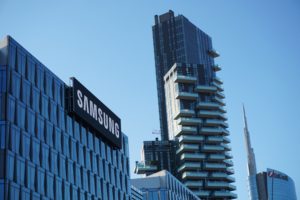
1. Samsung Electronics
2. Hyundai Motors – also owns 38.88% of Kia
3. SK Holdings – energy, chemicals, communications, materials, logistics and service.
4. POSCO - steel
5. LG Electronics
6. Korea Electric Power Corporation – utilities (nuclear, wind, coal)
7. Kia Motors
8. Hanwha – aerospace, chemicals & materials, solar energy, financial services, construction
9. Hyundai Mobis – parts and services for auto manufacturers
10. KB Financial Group – Banking
11. CJ Corporation – Food, pharmaceuticals, shopping, logistics, entertainment, media
12. GS Caltex – Fossil fuels
13. Samsung Life Insurance
14. Samsung C&T – Engineering & construction, trading, fashion, resorts.
Korean Money
The unit of money used in Korea is the Korean won (9/12). Both North and South Korea use the won, though the Southern country’s currency is more valuable. The won was first introduced as Korea’s national currency in 1902, replacing the yang (which had only recently replaced the Korean mun). However, Japan invaded Korea in 1910 and forced the country to adopt the Yen. The won was reintroduced as Korea’s national currency after the Japanese occupation ended in 1945. It was pegged to the US dollar, but the peg rate changed many times. Eventually, it was replaced by the Hwan (5/12) in 1953 due to the won losing value. Then, the Korean won (KRW) was reintroduced again in 1962. This final iteration of the won was pegged to USD until 1997 when it began to float freely in the market. Currently, 1 USD is worth 1,158 KRW. The Korean won can be divided into 100 jeon (8/12), but jeon is not used or known about by the general public. When I asked Koreans about it, they thought I was talking about Korean pancakes that have the same name in Korean.
References
https://www.investopedia.com/terms/c/chaebol-structure.asp
https://fortune.com/fortune500/
https://en.wikipedia.org/wiki/List_of_largest_companies_of_South_Korea
https://en.wikipedia.org/wiki/Hyundai_Motor_Company
https://www.sk-inc.com/en/about/overview.aspx
http://product.posco.com/homepage/product/eng/jsp/process/s91p2000110h.jsp
https://www.hanwha.com/en.html
https://english.cj.net/cj_introduction/global/global.asp
https://www.xe.com/currency/krw-south-korean-won/
https://www.xe.com/currencyconverter/convert/?Amount=1&From=USD&To=KRW

Religion
South Korea is a religiously tolerant society. In the past Confucianism and Buddhism dominated Korean society but it is now majority atheist with Christianity as the largest religion.
Buddhism arrived in Korea in 374 and spread across the peninsula before it unified as one nation. It is credited as the psychological force that led to the Unified Silla Period. It remained an important part of society for centuries. Buddhism is also responsible for the first “printing press” with moveable lettering - long before Gutenberg’s press. By the end of the Goryeo Dynasty, there were hundreds of Buddhist temples across the country. However, only the mountain temples (간사 - sansa) remain.
During the Joseon Dynasty, Confucianism (and Neo-Confucianism) was adopted as the state religion. The Buddhist monks were stripped of their power and the flatland temples were destroyed. The monks were forced into the mountains. Confucianism as a state religion would last until the Japanese occupation but it would not rebound as well as Buddhism did following the Korean War.
Nowadays, most Koreans identify as non-religious. Of those that identify as religious, 45% are Protestant, 35% are Buddhists, and 18% are Catholic.
Moonie
The Unification Church was established in Korea in 1954. It was founded by Moon Sun Myung (문선명). You might have heard of it as that Korean cult church that has those massive wedding ceremonies. It is generally known as a cult. The members of the church are called Moonies (12/12) after the family name of the church’s founder.
North Korea claims that their citizens have the freedom of religion, but in practice that is not true. It is difficult to get information from the hermit state, but there might be between 50,000 and 200,000 people in prison camps for practicing Christianity. North Korea is not very religiously tolerant. People practicing religions (in a way that the state doesn’t like) may be beaten, imprisoned, or killed. Their spouses may even be forced to divorce them. The state is about 71% atheist… in a way.
Juche
Juche (6*/12) is basically a religion in North Korea. It translates as “self-reliance” and is the official ideology of North Korea. It was created from the foundations of socialism. The leaders of the country are worshiped. Citizens must keep pictures of the leaders in their house and wear pins showing their loyalty. The three fundamental principles of Juche are: political independence, economic self-sustenance, and self-reliance in defense. These principles explain why it is an isolationist state. Juche is quite vague, so the leaders of North Korea can use it to justify anything they want. In South Korea, Juche is seen as the national religion of North Korea in a similar way to how Buddhism and Confucianism were state religions in the past.
References
https://www.korea.net/AboutKorea/Korean-Life/Religion
https://www.mcst.go.kr/english/culture/heritage/heritage.jsp?pMenuCD=3101021200
http://www.koreansansa.net/eng/sansa/sansa_01.do
http://www.koreanbuddhism.net/bbs/content.php?co_id=110
https://en.unesco.org/courier/december-1978/200-years-gutenberg-master-printers-koryo
https://www.pewresearch.org/fact-tank/2014/08/12/6-facts-about-christianity-in-south-korea/
Facts About Korea (2020). Korean Culture and Information Service Ministry of Culture, Sports and Tourism, 2020, https://www.factsaboutkorea.go.kr/bbs/view.do?nttId=NI_00000000000004161&ln=en. PDF download.
https://www.thegospelcoalition.org/article/9-things-know-unification-church/
https://www.state.gov/reports/2020-report-on-international-religious-freedom/north-korea/
https://www.vox.com/world/2018/6/18/17441296/north-korea-propaganda-ideology-juche

Nunchi
Finally, I want to talk about the inspiration for this list. In a meeting a couple months ago, one of my supervisors claimed that nunchi (4*/12) was in the dictionary. I was skeptical because it is a Korean concept that doesn’t really exist in the Western world, so there wouldn’t be a need to include it in most dictionaries. I quickly searched for it, but only found it on Wikipedia at that time.
Nunchi is a hard word to describe because there is no analogous term in English. That is also why it may be adopted by more English speakers going forward. The closest phrase in English might be ‘reading the room.’ Nunchi is a type of emotional intelligence or a social sensitivity. It is the ability to understand the moods of other people and know how to interact with them. Someone with a lot of nunchi knows what to say and how to say it. Someone with no nunchi is socially inept and says inappropriate things. I feel like nunchi is a very useful word to be adopted by other cultures.

Do you know of any other Korean words in English dictionaries? I looked at other lists online, talked to Koreans, and talked to foreigners living in Korea for ideas on what to look up. I also used my own intuition and accidently came across other words while searching. This is not an extensive list. I am also curious if there are any other Korean words you hope will be adopted by the Western world. I hope that nunchi is adopted, but maybe you have other ideas.
Thank you
I will finish off this article with a discussion of the dictionaries used and table with my results. But I think this is the best time to say thank you for reading my article. It took a long time to research and write. So, I am grateful that you took the time to read it.

Dictionary Analysis
Oxford English Dictionary
The dictionaries used are collectively seen as the top online dictionaries with the exception Oxford English Dictionary. Their paywall was unreasonable. Instead, I found the largest offline OED I could find at my school, Second Edition Oxford English Dictionary (2002). I think it was interesting to see how much has changed in the past 20 years. Many new Korean words have made their way into English dictionaries.
Wiktionary
Wiktionary was the best performing dictionary in regards to Korean words in English. Even if it doesn’t have the word, it will likely direct you to a Wikipedia page instead.
The Free Dictionary
Speaking of Wikipedia pages, I feel like the Free Dictionary is cheating. It is the only other dictionary with over 60 words, but it is not really a dictionary. It cross-references other dictionaries and Wikipedia. However, most of the content seems to just be a mirror of Wikipedia. So, I feel like it is more of a search engine than a dictionary.
Urban Dictionary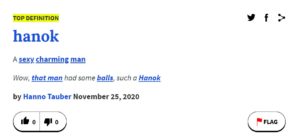
Another dictionary with a high total that needs an explanation is the Urban dictionary. On this website, users can create their own dictionary entries. This can lead to inaccurate definitions or people posting as a joke. You have to be skeptical of the entries on this website, but it was included because it is usually the first dictionary to describe new terms. When I am researching new words for my other posts, it pops up quite a bit. Any new words (hallyu) would first be seen here. Some of those entries were written by Koreans. However, there were a lot of incorrect definitions given for Korean words. If you would like to participate in propagating Korean words into English, consider joining the Urban Dictionary.
The Good and the Bad
Merriam-Webster Dictionary, Collins Dictionary, and Lexico all did a fairly decent job at describing Korean words. I like the way Merriam-Webster looks and is laid out. The two worst performing dictionaries were Macmillan and Cambridge Dictionaries. Google dictionary didn’t do as poorly as McMillan and Cambridge, but I was still disappointed. I guess I have higher expectations for Google.

Results
X = Not in the dictionary
O = It is in the dictionary
Here are the results:
| ENGLISH | KOREAN | Merriam-Webster | Shorter Oxford Dictionary 5th Edition (2002) | Collins | Macmillan | Cambridge | Dictionary.com | The Free Dictionary | Google Dictionary | Wiktionary | Urban Dictionary | American Heritage Dictionary | Lexico |
|---|---|---|---|---|---|---|---|---|---|---|---|---|---|
| Aegyo | 애교 | X | x | x | x | x | x | x | x | o | o | x | x |
| arirang | 아리랑 | x | x | x | x | x | x | o | x | o | o | x | x |
| banchan | 반찬 | x | x | x | x | x | x | o | x | o | o | x | x |
| Bibimbap | 비빔밥 | O | x | O | o | o | x | o | o | o | o | o | o |
| bali bali | 바리 바리 | x | x | x | x | x | x | x | x | x | x | x | x |
| Busan / Pusan | 부산 | O | x | o | x | x | o | o | x | o | o | o | o |
| Bulgogi | 불고기 | O | x | X | x | x | x | o | o | o | o | o | x |
| Chaebol | 재벌 | O | o | o | o | o | o | o | o | o | o | o | o |
| cheonmin | 천민 | x | x | x | x | x | x | o | x | x | x | x | x |
| Chimaek | 치맥 | x | x | x | x | x | x | x | x | x | x | x | x |
| Chuseok | 추석 | x | x | x | x | x | x | o | x | yes, but far down the list | x | x | x |
| daebak | 대박 | x | x | x | x | x | x | x | x | o | o | x | x |
| doenjang jjigae | 된장찌개 | x | x | x | x | x | x | o | x | o | o | x | o |
| Galbi | 갈비 | X | x | x | x | x | x | o | x | o | o | o | x |
| Gangnam | 강남구 | X | x | x | gangnam style | x | x | multiple entries!! | x | o | o | x | x |
| gayageum | 가야금 | x | x | x | x | x | x | o | x | o | x | x | x |
| Gimbap / Kimbap | 김밥 | x | x | x | x | x | x | o | x | o | not quite right | x | x |
| Gochujang | 고추장 | O | x | O | x | o | x | o | o | o | x | x | o |
| Gook | O | o | x | o | x | x | o | o | o | o | o | o | |
| hallyu | 한류 | x | x | x | x | x | x | article about it | x | o | o | x | x |
| Hapkido | 합기도 | O | x | o | x | x | x | o | o | o | o | x | o |
| Hanbok | 한복 | X | o | x | x | x | o | x | o | o | x | o | |
| Hanja | 한자 | x | x | x | x | x | x | o | x | o | unclear meaning | x | x |
| Hanji | 한지 | x | x | x | x | x | x | o | x | Japanese | x | x | x |
| Hankook | 한국 | X | x | x | x | x | x | x | x | x | x | x | x |
| Hangeul | 한글 | x | x | x | x | x | x | o | x | o | x | x | x |
| hangul | 한글 | o | o | o | x | x | o | o | x | o | magazine | o | x |
| hanguk | 한국 | x | x | o | x | x | o | o | x | o | o | x | x |
| Hantavirus | 한타바이러스 | O | o | o | x | x | o | o | o | o | x | o | o |
| Hantaan virus | 한타바이러스 | O | x | x | x | x | x | o | x | x | x | x | o |
| Hwan | 환 | o | x | o | x | x | o | o | x | o | x | x | x |
| Hyundai | 현대 | X | x | x | x | x | x | o | x | o | o | x | x |
| jjimjilbang | 찜질방 | x | x | x | x | x | x | o | x | o | x | x | x |
| Jeju / Cheju | 제주도 | o | x | o | x | x | o | o | x | o | o | o | x |
| Joseon | 조선 | x | x | x | x | x | x | o | x | o | x | x | x |
| Juche | 주체 | X | x | pending approval | x | x | x | o | o | o | o | x | o |
| jun / jeon | 전 | o | o | o | x | x | o | o | o | o | Korean name | x | o |
| kakao | 주식회사 카카오 | x | x | x | x | x | x | x | x | x | x | x | x |
| hanok | 한옥 | x | x | x | x | x | x | o | x | o | sexy man | x | x |
| Inchon / Incheon | 인천광역시 | o | x | o | x | x | o | o | x | o | o | o | o |
| kdrama | 한국드라마 | x | x | x | x | x | x | o | x | o | o | x | x |
| kia | 주식회사 기아 | x | x | x | x | x | x | x | x | o | x | x | x |
| Kimchi | 김치 | O | o | O | o | o | o | o | o | o | o | o | o |
| Kisaeng | 기생 | O | o | x | x | x | x | o | x | o | x | x | x |
| kpop k-pop | 케이팝 | o | x | o | o | o | o | o | o | o | o | x | o |
| Korea | 한국 | O | x | o | o | o | o | o | x | o | o | o | o |
| koreaboo | x | x | x | x | x | x | x | x | o | o | x | x | |
| korean | 한국인 | o | o | o | o | o | o | o | o | o | o | o | o |
| Korean Barbeque | x | x | x | x | x | x | redirects to galbi | x | x | sexual act | x | x | |
| Korean War | 한국전쟁 | x | o | o | x | x | o | o | x | o | o | o | o |
| Koreatown | x | x | x | x | x | x | o | x | o | seems a little racist | x | o | |
| lg | 주식회사 엘지 | x | x | x | x | x | x | x | x | x | x | x | x |
| Makgeolli | 막걸리 | X | x | x | x | x | x | o | x | o | x | x | o |
| Moonie | O | o | o | o | o | o | o | o | o | o | o | o | |
| Mukbang | 먹방 | X | x | o | x | x | o | x | o | o | o | x | o |
| Mun | x | x | x | x | x | x | x | x | x | x | x | x | |
| namsan | 남산 | x | x | x | x | x | x | o | x | x | sort of correct? | x | x |
| noarebang | 노래방 | x | x | x | x | x | x | x | x | o | o | x | x |
| nunchi | 눈치 | x | x | pending approval (2019) | x | x | x | o | x | o | o | x | x |
| Oppa | 오빠 | X | x | x | o | x | x | x | x | o | o | x | x |
| Ondol | 온돌 | X | x | x | x | x | x | o | x | o | o | x | o |
| pansori | 판소리 | x | x | x | x | x | x | o | x | o | x | x | x |
| pc bang | PC 방 | x | x | x | x | x | x | o | x | o | o | x | x |
| Samsung | 삼성 | X | x | x | x | x | x | o | x | o | o | x | x |
| samgyeopsal | 삼겹살 | x | x | x | x | x | x | o | x | o | x | x | x |
| Seoul | 서울 | O | x | o | x | o | o | o | x | o | o | o | o |
| Sijo | 시조 | O | o | o | x | x | x | o | x | o | x | x | x |
| Soju | 소주 | O | x | o | x | x | x | o | o | o | o | o | o |
| ssireum | 씨름 | x | x | x | x | x | x | o | x | in Korean 씨롬 | x | x | x |
| Taegukgi | 태극기 | x | x | x | x | x | x | x | x | x | cloth diaper | x | x |
| Taekwondo | 태권도 | O | o | o | o | o | o | o | o | o | o | o | o |
| teok / ddeok | 떡 | x | x | x | x | x | x | o | x | o | redirects to rice cake | x | x |
| tteokbokki | 떡볶이 | x | x | x | x | x | x | o | x | o | o | x | x |
| Won | 원 | O | o | o | x | x | o | o | o | o | x | o | o |
| yang | 양 | x | x | x | x | x | x | x | x | o | x | x | x |
| yangban | 양반 | x | o | x | x | x | x | o | x | o | x | x | x |
| Totals = | 25 | 14 | 27 | 11 | 10 | 19 | 62 | 17 | 65 | 50 | 19 | 27 |


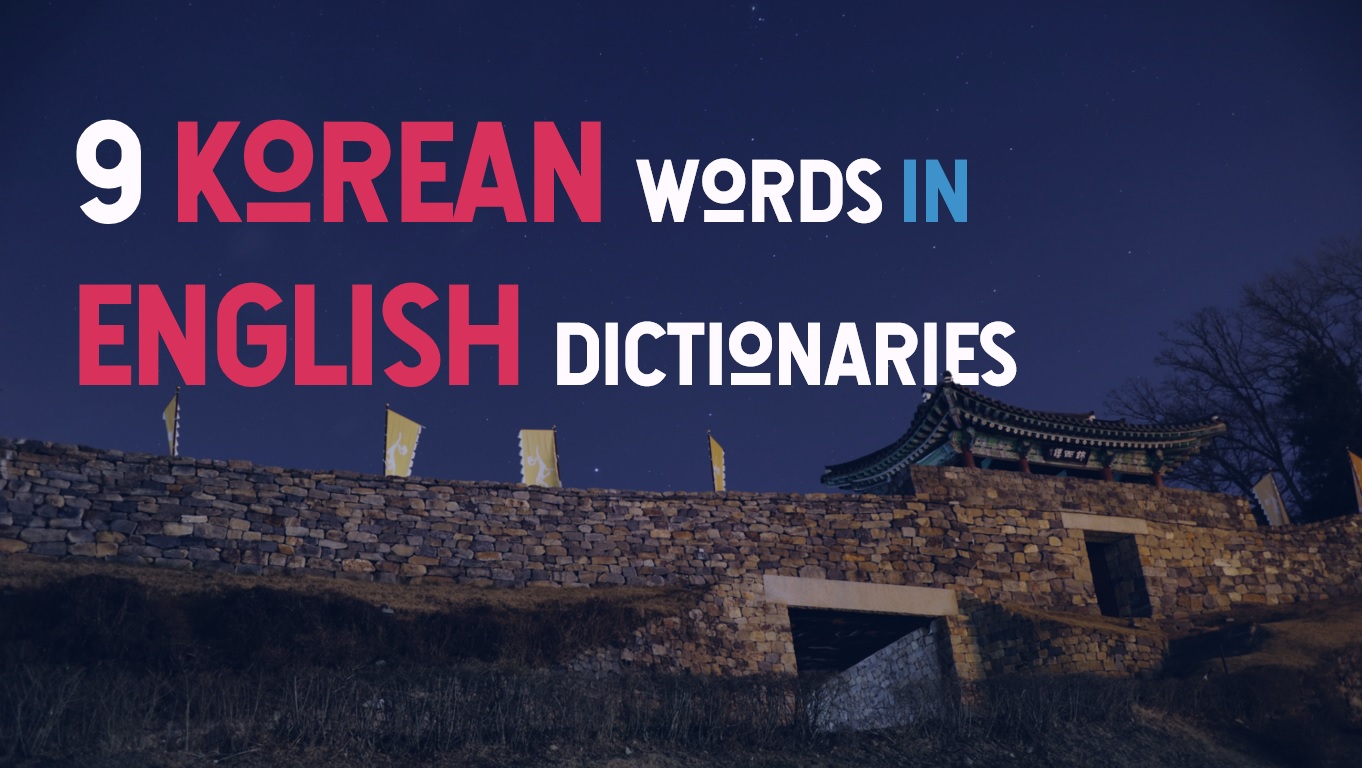
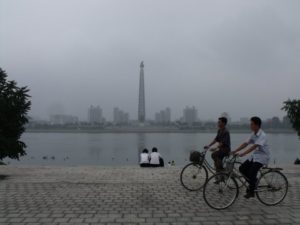
FYI: Regarding ‘gook’
1.
Term gook was given by American soldiers during most wars happened in asia inc. Vietnam Philippine Korea China Japan etc. these terms were and still are used to degrade those people as same as chinks or japs and yes it is a strong racist word
2.
As we all know Korea and Japan used Chinese characters long ago before creating their own and lot of Korean words may written in hangeul but it may still contain the meaning of Chinese character like harmonium of English, sounds the same but different meanings or spellings
So the gook that is used in terms as migook hangook younggook these gooks came from Chinese character 國 meaning country
Hope you find this helpful
Ps: did you know that Korea used to be spelled Corea from all those Spanish merchants who came to “Goryeo” for ginseng trade that has changed by Japanese because of the alphabet order🤪
Thanks. Yes, I am aware.
1. Gook existed before the Korean war, I just thought it was an interesting etymology.
2. The Chinese characters used in Korea became hanja. I wasn’t aware that 국 came from Chinese but it doesn’t surprise me.
3. I knew Corea came from Goryeo Kingdom, but I didn’t know it was the Spanish who established this spelling.
Very interesting, thank you for commenting.